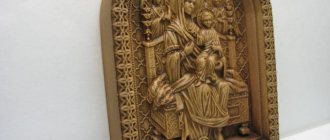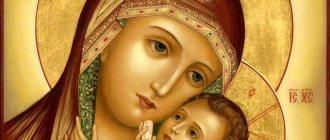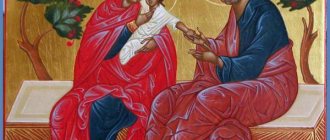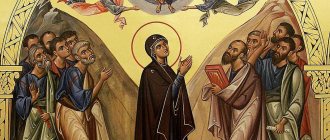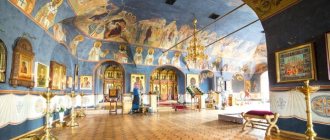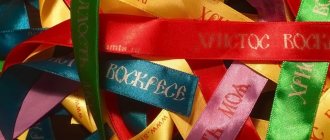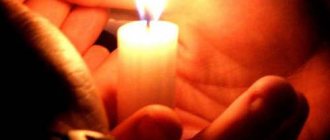What does the relic mean and where is it located?
The iconographic typology of the image is close to the style of “Hodegetria” (“Guide Book”).
On it, the Heavenly Queen points to the Son of God as the path that saves the person who follows it from sins, illnesses, fears and suffering. The scroll in the Savior’s left hand represents the Gospel - Divine revelation given to people. And His right hand, extended in a blessing gesture, seems to overshadow the audience, giving them peace and hope. Another characteristic detail of the relic is the royal throne on which the Virgin Mary sits. Like her purple vestments, this throne symbolizes the supreme power of the Lord, whose power surpasses any earthly laws and prohibitions.
On both sides of the Virgin Mary stand angels - one is shown with his arms crossed on his chest and a raised wing (this pose denotes reverent concentration and readiness to submit to the Will of the Creator), and the other seraphim stretches out his hands to the Mother of God, begging Her for mercy.
The original icon of the Mother of God “The All-Tsarina” (its ancient Greek name is “Παντάνασσα”, All-Merciful) resides in the Vatopedi Lavra on Mount Athos . Now the miniature image is located near the north-eastern column of the cathedral. According to the chronicle, his glorification began in the 17th century. thanks to the righteous elder Joseph the Hesychast. The ascetic also spoke about the first miracle created by the shrine.
Vatopedi Monastery on Holy Mount Athos
One day a man entered the temple, wanting to venerate the relic. However, as soon as he approached the altar, the face of the Mother of God flashed with radiant light and the pilgrim was thrown away from the icon. Rising, the shocked sinner confessed that he had repeatedly violated the Lord's commandments by practicing witchcraft - and he came to the monastery to test the power of his conspiracies. But the intervention of the Virgin Mary forever turned this man away from demonic sorcery, making him humble and fearing God.
But in fact, the history of such images is much older. Thus, in Mystras (Byzantium), a church dedicated to the All-Merciful Mother of God was erected back in 1428. And Queen Maria Palaeologus, the wife of the Moldavian prince, in 1500 presented a relic of the Athos Gregorian monastery, painted in a similar manner. Another similar shrine, created by Theophan of Crete himself, is in the Lavra of St. Athanasius - this monastery takes precedence over all the temples of the holy Mount Athos.
History of the village and its current state
On June 30, 1772, Catherine the Second signed a letter of commendation to the Black Sea Army. Among the first 38 kurens - Cossack villages founded by the Black Sea Cossacks in the Kuban, there was the Plastunovsky kuren. Its name comes from the plastuns - foot Cossack scouts who inhabited it.
The history of the Plastunovsky kuren begins in 1794. Initially it was located on the Kuban River, west of the modern village of Starokorsunskaya. In January 1801, according to the list of the Kurenny Ataman, 44 married Cossacks, 124 single Cossacks, 85 teenagers lived in Plastunovsky - a total of 291 men and 115 women.
Frequent clashes with the mountaineers forced the Plastunites to turn to the military authorities with a request to move away from the Kuban further into the steppe. In 1814, the village was moved north, to its modern location on the banks of the Kocheta River.
The Kochety River in places is swampy in the village of Plastunovskaya
In 1819, the first school was opened in Plastunovskaya on the territory of the future Dinsky district. And in 1899, the construction of the Church of the Ascension of the Lord was completed here, which is now the hallmark of the entire Dinsky district.
Street to the Ascension Church in Plastunovskaya
In 1915, 11.2 thousand people lived in the village of Plastunovskaya, now in 2021 almost the same number of people live in the village - 12.2 thousand people.
In Plastunovskaya there are no multi-storey apartment buildings, as in the neighboring large village of Dinskaya, there are only private houses with gardens and personal plots.
You won’t see particularly luxurious mansions in Plastunovskaya; there are modern 2-3-story houses and old, modest one-story houses.
3-storey brick house in Plastunovskaya
An older one-story building in Plastunovskaya
Near most houses and along the streets of the village in spring and summer it is green and colorful with flowers. Therefore, after the bustle of the city, it can be pleasant to stroll along a village street, admire the flowers or geese near the houses.
Flowers in front of a house on one of the streets of the village
Geese in the grass in front of the village house
How does the “Tsaritsa” icon help?
This shrine has the grace of healing oncological diseases - from benign cysts and papillomas to leukemia, sarcomas and carcinomas. When the disease progresses and the need for surgical intervention arises, the image helps both the patient and his loved ones cope with despair, fear, doubt and anxiety. The feeling of the presence of the Mother of God, which arises when looking at Her face, eases mental and physical pain, gives peace and allows you to find inner balance.
In addition, the prayer to the “Tsaritsa” icon relieves cravings for tobacco, alcohol and drugs, removing the shackles of obsession with a harmful substance from a person. The sufferer himself, as well as his relatives or friends, can appeal to the relic.
This image also protects the house from spells and magical influences. His amazing power dispels any evil, drives away demons, pacifies enemies, ill-wishers and competitors.
Miraculous lists of the icon of the Mother of God
There are copies of the relic in many Orthodox churches in Ukraine, Belarus, Russia, Moldova, Serbia, and Greece. The commemoration of the image falls on August 18 (31) , but services at the holy face are held every week.
One of the most famous lists is kept in the Kiev Pechersk Lavra (Cathedral of the Reverend Fathers of the Pechersk). Many confirmed healings take place near the relic - for example, a girl diagnosed with optic nerve glioma, who had almost lost her sight and hearing, saw a shining image and a priest standing next to it, and a few days later she was able to hear the words addressed to her.
Holy Dormition Kiev-Pechersk Lavra
The Icon of the Mother of God “The All-Tsarina” is also in other monasteries - for example, St. Michael’s Golden-Domed Cathedral, the Church of the Icon “Pantanassa” in Kyiv, the Intercession Monastery in Kharkov. Churches in Odessa are dedicated to her, Smt. Pervomaisk (Kharkov region) and Krasny Liman (Donetsk region).
A copy of the shrine was brought to Russia on August 11, 1995. It was written with the blessing of the rector of Vatopedi, Archimandrite Ephraim, especially for the Community of Mercy at the Children's Cancer Center. And on the feast of the Nativity of the Virgin Mary, a miracle happened - Her face began to stream myrrh. Drops of fragrant oil appeared on the image on the day of the Entry of the Most Holy Theotokos into the temple. Since then, healings have regularly occurred at the relic - for example, in 1996, a young man who suffered from drug addiction got rid of his addiction. Now this icon is in the church of the Novo-Alekseevskaya monastery, from where it is regularly sent to various hospitals and hospices.
Church of All Saints in the Novo-Alekseevsky Convent
In 2004, a copy of the relic from the Holy Trinity Monastery was recognized as a locally revered shrine of the Yekaterinburg diocese. This was facilitated by reports of cure, confirmed by medical reports. And the image from the Lady’s Convent of Serpukhov began to stream myrrh in 2000 - and since then, an akathist to the icon of the Mother of God “The All-Tsarina” has been read daily in front of it, accompanied by the blessing of water and oil. In addition, during the prayer service, priests remember the names of people suffering from cancer.
Serpukhov Vladychny Convent
However, one of the most famous copies of the shrine is the image from Krasnodar, created by the Russian master V. A. Polyakov in 2005. In order to reproduce the face of the Mother of God, he went to the Vatopedi Monastery during Lent, and made the first strokes in Holy Week. When the work was completed, even the governor of the monastery and the Greek icon painters admitted that it was completely consistent with the original. The icon was consecrated on Easter, attached to 130 relics stored in the Athonite laurels - among them there is even the belt of the Heavenly Queen!
Convent of the Icon of the Mother of God “Vsetsaritsa” in the city of Krasnodar
And our online store “Yantar Polesie” will help you purchase a relic for your home iconostasis. The master accurately reproduced the canonical image, using solid gemstones and shimmering semi-precious chips. Thanks to this, the shrine looks sublime and inspired, calling for prayer, consoling in sorrow and granting salvation to the soul.
What is noteworthy about Plastunovskaya
Church of the Ascension of the Lord
The modern building of the Church of the Ascension of the Lord in Plastunovskaya was erected in 1899; it was built in the center of the village, in the Byzantine style, with 5 golden helmet-shaped domes.
The temple is marked on the map for the article in pink with No. 1. The size of the temple does not correspond to the size of the village - such a large temple would be common to see in a big city, and not in the village, among fields and private houses. But nevertheless, it stands exactly there, to the surprise and admiration of its visitors.
Church of the Ascension of the Lord in Plastunovskaya
The history of the temple has its own legend about the salvation of the Mother of God. In 1933, at a time when there was a struggle against the church and churches were being destroyed everywhere, they also wanted to blow up the church in Plastunovskaya. It was not possible to destroy the temple at once, since there was not enough explosives, so they decided to blow it up in parts. Dynamite was placed on the north side of the temple. There was an explosion and the entrance partially collapsed. At the same time, a woman’s cry was heard in the temple. Having opened the doors, they discovered that the crying did not subside, but was heard from one or another place in the temple. The perpetrators of the explosion felt uneasy and decided to postpone the plan until the next day. In the morning people gathered at the temple. When they opened the door, they heard crying again, and someone said: “This is the Mother of God crying.” And they did not dare to continue the destruction of the temple. Thus, through the prayers of the Mother of God, the temple was saved.
There are many shrines in the Church of the Ascension of the Lord. The most revered icon is the 16th century icon of the Vladimir Mother of God, brought by the Cossacks-Plastuns to found the village and church.
Also in the temple, the icon of the great martyr and healer Panteleimon is especially revered. It was brought by Plastun Cossacks from a pilgrimage to the holy Mount Athos in Greece. On the reverse side there is an inscription that the consecration of the icon took place on the holy Mount Athos in the Russian St. Panteleimon Monastery in 1881.
The most ancient shrine of the Church of the Ascension of the Lord is a particle of the relics of Pope Clement, a disciple of the Apostle Paul of the 2nd century AD.
A wonderful decoration of the temple is the ancient iconostasis - carved, three-tiered, gilded. It is crowned with an icon of the Lord Pantocrator. The iconostasis was brought in 1957 from a closed church in Kyiv. In the anniversary year of 1999, the icon of the Ascension of the Lord, which is also located in the iconostasis, was painted and donated to the temple.
The area around the temple is very well maintained, there are beautiful clubs, a children's playground, etc.
Bells near the playground near the temple
Flowerbed near the temple
4 rare Soviet monuments and a stanitsa park
Amazing Soviet monuments have been preserved in the village of Plastunovskaya.
Hammer, sickle and coat of arms of the USSR on a brick platform between houses in Plastunovskaya
Monument to the Soviet Family - also between the houses
The sculpture of the Collective Farmer stands on an island in the middle of the pond
Statue of Lenin against the background of an arch in front of the Park of Culture and Leisure named after the 22nd Congress of the CPSU
All these monuments are marked in red on the map above.
Prayer to the “Tsaritsa” for oncology
First prayer
O most pure Mother of God, All-Tsarina! Hear our much-painful sigh before Your miraculous icon, brought from the Athos inheritance to Russia, look upon Your children, those suffering from incurable ailments, who fall to Your holy image with faith! Just as a winged bird covers its chicks, so You, now and ever-living being, have covered us with Your multi-healing omophorion. There, where hope disappears, awaken with undoubted Hope. There, where fierce sorrows prevail, Appear with Patience and Weakness. There, where the darkness of despair has settled in the souls, let the ineffable light of the Divine shine! Comfort the faint-hearted, strengthen the weak, grant softening and enlightenment to hardened hearts. Heal Your sick people, O all-merciful Queen! Bless the minds and hands of those who heal us; may they serve as an instrument of the Almighty Physician Christ our Savior. As if You are alive and present with us, we pray before Your icon, O Lady! Extend Your hand, full of healing and healing, Joy to those who mourn, Consolation to those in sorrow, so that with miraculous help we soon receive, we glorify the Life-Giving and Indivisible Trinity, the Father and the Son and the Holy Spirit, forever and ever. Amen.
Second prayer
All-merciful, venerable Mother of God, Pantanassa, All-Queen! I am not worthy, but come under my roof! But as a merciful and gracious Mother of God, say the word, may my soul be healed and my weak body strengthened. You have an invincible power, and all your words will not fail, O All-Tsaritsa! Beg for me! You begged for me. May I glorify Your glorious name always, now and forever. Amen.
